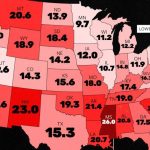The Pennsylvania Department of Health refuses to share complete information about how it counted COVID-19 deaths for reports ordered by the Pennsylvania House of Representatives.
The reports were ordered a year ago when the House unanimously approved a resolution in November 2020, requiring the Legislative Budget and Finance Committee (LBFC) to review the Department of Health’s reporting of COVID-19 testing and deaths.
State Rep. Kate Klunk sponsored the legislation, House Resolution 1087 of 2020, noting that throughout the pandemic, there have been discrepancies in the information published by the Department of Health, including thousands of COVID-19 positive cases being removed from the daily totals, days where there were significant statistical anomalies in the data, the commingling of data, and COVID-19 being listed as a factor of death when the death was the result of something else.
The LBFC was tasked with providing rolling reports continuing until 90 days after Governor Tom Wolf’s emergency declaration ends. That declaration ended in June and five months later, on Wednesday, the LBFC issued its first report (pdf) after being delayed due to a lack of information.
The LBFC is a bipartisan body made up of state representatives and senators. It routinely conducts studies within the state government.
“Our intent was to review death certificates/records for individuals who had COVID-19 listed on their death record,” the report says. And although information LBFC sought is generally confidential under the state’s 1953 Vital Statistics Law, the law provides exceptions to that confidentiality, allowing for the Department of Health to share the information with government agencies, and it permits sharing the information for research.
Nonetheless, LBFC’s request for death records was denied.
The Department of Health said in letters that the LBFC is not an ‘agency of government’; its work is not ‘in the interest of conduct of official duty,’ and that its work studying and analyzing the reporting of death records is ‘not research.’
“We strongly disagree with the department’s position on each of these points,” the report says.
The LBFC finally received what it described as “highly redacted information.” With that, it issued the report with a “scope limitation.” It means the report attempts to answer a research question, but the limitations imposed by the lack of access to information impairs the ability to arrive at an answer.
“Unfortunately for the people of Pennsylvania, the Wolf administration attempted to shield data needed by the LBFC to do its review,” Klunk said in a statement Wednesday. “It’s mind boggling to me that a branch of government would try to deny a bipartisan, bicameral government entity that routinely examines data, and performs research, information it needs to complete its task.”
Study findings
The LBFC noted that this is the first of what will be several studies related to COVID-19 data reporting and it made some recommendations.
1. The Department of Health should improve its data collection and presentation on its website. While COVID-19 data is plentiful, it needs better descriptions of its source and where and why it may conflict with other presented data sources. And the Department should resolve the inconsistent reporting that is apparent in long-term care facility data, the report said.
2. The Department should monitor the accuracy in cause of death reporting by creating a task force to address ongoing issues. Cause of death reporting was an issue before the pandemic, the report said. Since the pandemic, the need for accurate cause of death reporting has been emphasized. The taskforce should include coroners, physicians, funeral directors, and medical schools. It should work to improve reporting.
3. The General Assembly should consider amending the Vital Statistics Law to expressly grant access to the records to legislative agencies. To avoid any future confusion.
The 110-page report goes into detail about the intentions of the study and the difficulties in obtaining data. Both the LBFC and the Department of Health used attorneys to negotiate for, or block access to data.
The report provided demographic information. Of those who died of COVID-19 in 2020, there were 8,092 females and 7,886 males. Asians numbered 266; the category “other” shows 573 deaths; and there were 2,243 black deaths and 12,896 white deaths.
In 2020, no one under the age of 14 died from COVID-19 in Pennsylvania, the report shows, and five died in the age range 15–19. Deaths increase with age noticeably around 60 and the majority of people who died from COVID-19 in 2020 were aged 85–89. In that age group, 2,792 died.
“This data shaped policies imposed by Gov. Tom Wolf throughout this pandemic,” Klunk said. “He and all Pennsylvanians have a right to know that the data driving public health policy and individual health choices is reliable. If the governor wants a ‘Government that Works,’ he and his administration must be willing to not only talk the transparency talk, but walk the transparency walk by releasing this data and working with the LBFC.”

In a Nov. 3 letter to the LBFC, acting Secretary of Health Alison Beam held to the position that the department is not authorized by law to share the requested death records with the LBFC.
“The department worked closely with LBFC to support its drafting of the report and is pleased to see the result will largely serve as a great educational tool for the General Assembly and the Public,” Beam wrote. “The department believes that Pennsylvanians have a right to accurate and concise data and information related to the COVID-19 pandemic response.”











